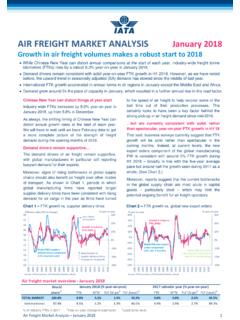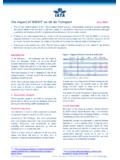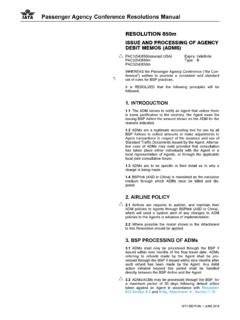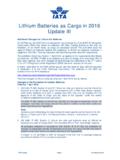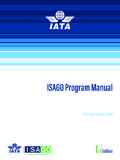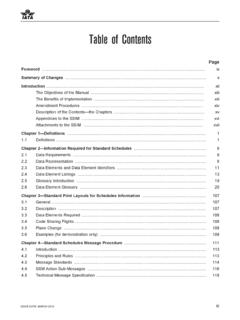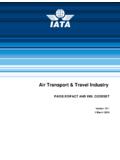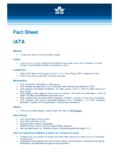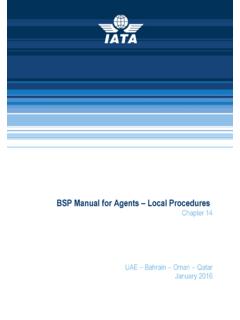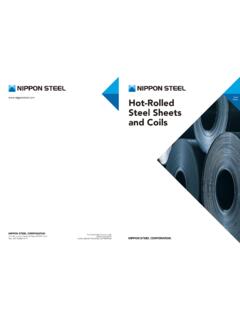Transcription of Aviation Carbon Offsetting Guidelines for Voluntary …
1 Aviation Carbon Offsetting Guidelines for Voluntary Programs VERSION III April 2022 Summary These Guidelines set out a systematic approach to establishing an offset program. The document is intended for use by airlines that wish to include Offsetting as part of their overall efforts to reduce Carbon dioxide emissions (CO2). The document will lay out the concept of Carbon Offsetting first. This will be followed a step-by-step approach to setting up and managing a Carbon offset scheme, summarized in the table below. In the main sections, each step is explained along with relevant advice. SECTION STEP MAIN TOPICS 00 Introduction Outlining the concept Voluntary vs. mandatory Offsetting 01 Role of Offsets When to use offsets Identifying stakeholders What are potential risks 02 Scope of Offsets What activities to offset Flight-related emissions 03 Regulations and Budget Regulatory implications Review of cost implications Possible tax implications Maintenance and support 04 Offset Proposition Offset functionality embedded in airline Booking process vs.
2 Click away Frequent Flyer Program Complete / partial offset 05 Offset Projects and Standards Programmes and standards Type & Price of Project Customer preferences Registry arrangements 06 Program Management Choosing the partners Internal responsibilities Managing the program 07 Setting up the System Customer interface Carbon calculator Airline interface 08 Launch and Operations Preparing for launch Audit and verification Feedback and Communications Introduction This document provides guidance to airlines that consider offering CO2 Offsetting to passengers as part of their overall climate action activities. By the time of writing, some 40 airlines are operating passenger Offsetting programs, each with different characteristics.
3 This section explains the nature of Carbon offsets and the basic principles. What are Carbon Offsets? In general terms, an offset is a compensating equivalent. As an activity, it can mean to balance, cancel out or neutralize. In the context of addressing climate change, Offsetting is an action by companies or individuals to compensate for Carbon emissions, in this case arising from their use of commercial Aviation services. The offset can be equivalent in part or in whole to the associated emissions, by financing a reduction in emissions elsewhere. There are many ways to achieve CO2 reductions with offsets, many of which bring other social, environmental, or economic benefits relevant to sustainable development.
4 Significant differences exist between offset types. How does Offsetting work? In simple terms, when an activity like air travel produces CO2 emissions, these emissions can be compensated or offset by preventing or reducing a similar amount of emission elsewhere. This compensation can be performed by the airline itself or by its passengers. Such offsets can be sourced from various types of project activities and can be purchased through specialized offset providers or Carbon brokers. The buyer then receives a certificate or record from the seller providing details about the project and the amount of reduced CO2 emissions. The diagram below illustrates this process: Principles of Carbon Offsetting In order to instil confidence in the purchase and use of Carbon offsets and ensure quality of offset programs in general, a number of principles should be respected.
5 Additionality A key requirement for an offset is that the CO2 reduction or removal used as an offset is additional to business-as-usual activity. Demonstrating additionality is complex, but a number of approaches have been used successfully to ensure the environmental integrity of offsets. Complementarity Voluntary Offsetting should be considered as part of wider efforts to reduce emissions alongside other measures such as technological development and operational improvements. Offset programs will only be credible if coupled with serious efforts to minimize the company s CO2 emissions first. Verification Records of aircraft CO2 emissions from operations covered by the offset program must be maintained and be externally verified by an independent third-party entity.
6 Registration CO2 reductions from offset projects should be recorded and tracked through a central registry, with the amounts purchased progressively subtracted from the total determined for that particular project. Traceability The receipt issued to the customer should clearly indicate that the credit has been, or will be, retired as a result of the purchase and cannot be resold. A receipt may also indicate the type of project that was used to generate the offset, or the quality standard that the offset meets. Guarantee If an offset is sold where the purchased reduction in CO2 will be achieved at some future date, then a guarantee that an alternative and equivalent offset will be made if the project fails should be provided.
7 IATA suggests that preferably only offsets already achieved are included. Voluntary vs. Mandatory Offsetting The importance of making a clear distinction between airline mandatory Offsetting requirements and Voluntary passenger action such as Voluntary offsets cannot be understated in particular given the worldwide implementation of the ICAO Carbon Offsetting and Reduction Scheme for International Aviation (CORSIA)1. That is a mandatory scheme set out to address the growth in emissions from international Aviation which contains Offsetting requirements for airlines. In addition to an airline s full suite of climate action measures, passengers can act as well and make a conscious decision to voluntarily invest in Carbon offsets.
8 In summary, a mandatory scheme such as CORSIA is needed to address Carbon neutral growth of the Aviation industry, whereas Voluntary offset schemes are targeted at passengers to reduce their own footprint. Airlines cannot make any claims for offsets that passengers have voluntarily invested in. They can also not use such offsets for frameworks like CORSIA. It will be of utmost importance that any information to customers make a clear distinction between passenger Voluntary action and any other climate mitigation activities that are of mandatory nature ( , CORSIA), avoiding any confusion between the two. 1 1. Role of Offsets When to use Offsets? Global Aviation accounts for some 2% of man-made Carbon emissions.
9 In 2021, at the 77th IATA annual meeting, the industry committed to achieve net zero CO2 emissions by Achieving net zero in Aviation requires a lot of effort from both within the industry and also outside of it. Sustainable Aviation fuels (SAF), Offsetting , new technologies, infrastructure and operation improvements are especially crucial to achieving this goal. For more details on the net zero goal, see the IATA website: Fly Net Zero. The Aviation industry is confident that technology, operations, and infrastructure measures will provide long-term solutions for Aviation s sustainable growth. However, to completement these measures, and take actions with a more immediate effect, a customer-based offset program could be considered to reduce the net impact of flying by achieving equivalent Carbon reductions from actions taken outside the Aviation industry.
10 Correspondingly, arguments supporting Offsetting include: Increasingly, customers are looking for the opportunity to reduce the environmental impact of their flights. Offsetting is a positive action that can be taken immediately by customers to help mitigate Aviation s impact on climate change. Through an offset program, customers can contribute directly to emissions reductions, and, at the same time, be informed about Aviation s climate impact and associated mitigations measures. Customers can choose from a range of projects ( , reforestation, wind energy) that gives them a sense of empowerment and choice. Identification with specific projects can improve customer response, thus improving the credibility of the offset program.
